The National Fire Protection Association (NFPA) requires that all RVs be equipped with at least one RV fire extinguisher. But we recently decided to upgrade our fire extinguishers to a fully automatic RV fire suppression system.
In this post, we’ll talk about the differences between a traditional fire extinguisher and a fire suppression system and why we decided to move to a suppression system despite having carried extinguishers for the past 20 years.
We’ll also share some of the best fire extinguishers for any rig and the RV fire suppression system we chose to protect our own RV.
Fire safety is an important topic (we recently wrote about RV fire escape ladders) so let’s dive right in!
- 1) Why Is Every RV Required to Have a Fire Extinguisher?
- 2) What Are the Areas Most Vulnerable to Fire on an RV?
- 3) What Are the Requirements for Fire Extinguishers on an RV?
- 4) How to Use a Manual Fire Extinguisher
- 5) Portable Fire Extinguishers
- 6) What’s the Difference Between a Fire Extinguisher and an RV Fire Suppression System?
- 7) Our Choice for a Fire Suppression System for Our RV
- 8) Why Proteng Over Other Fire Suppression Systems?
- 9) What’s Your Fire Safety Plan?
- 10) Free RVing Tips, Tricks, Reviews, Giveaways & More
Why Is Every RV Required to Have a Fire Extinguisher?
In addition to the requirements mandated by the NFPA, a traditional dry chemical extinguisher is the minimum tool needed to put out several types of fires that can start on an RV.
In addition, an RV fire can move incredibly fast so a rig can be quickly engulfed by fire and smoke.
There are often flammable materials and fuels on board — gas or diesel on a motorhome, and propane on rigs of all types.
So, every RV is required to have at least one extinguisher on board because the ability to suppress a fire as quickly as possible is critical to the safety of those on board.
What Are the Areas Most Vulnerable to Fire on an RV?
There are lots of reasons a fire might start on an RV, and several areas are especially vulnerable.
According to the U.S. Fire Administration, the most common causes of RV fires are equipment failure or user error (also known as a self-inflicted wound).
As you might assume, a common area where RV fires tend to start is in the kitchen — in particular the propane stove/oven or the RV refrigerator.
Propane-powered RV fridges are a common fire ignition point due to the combination of heat, propane, and electricity used to power them. (Take a look back at our power on RV absorption refrigerators to see how they use heat to keep things cold.)
An engine compartment, generator, electrical components, wheel bearing, tires, brakes, propane RV refrigerator, stove & oven, and propane-fueled water heaters make an RV especially vulnerable to fire.
Add human actions such as smoking, using candles, or even building a campfire too close to an RV and you can see why being adequately prepared to deal with fire is so important.
We’ll let Mac the Fire Guy provide further details about the common causes of RV fires, and then we’ll get into the types of fire extinguishers that are required in various locations.
What Are the Requirements for Fire Extinguishers on an RV?
There are some specific guidelines related to fire extinguishers in every RV. They’re related to the class (type) of extinguisher we need to carry as well as where they should be installed.
Let’s take a look at the NFPA requirements.
Class of Extinguishers
Portable/manual fire extinguishers are rated by class. Each class of extinguisher refers to the substance inside it and what types of fires they’re rated to put out.
We’ll go through the various ratings briefly, but the most important thing for RV owners to know is that the NFPA requires that all RVs have a B/C rated fire extinguisher. Note that there are A/B/C fire extinguishers (tri-class) that are considered multi-purpose and are excellent for RV safety.
Let’s take a quick look at the ratings of portable fire extinguishers and what each one covers.
- Class A – ordinary combustibles (for example wood, paper, textiles, cloth, trash, rubber, and plastics)
- Class B – flammable liquids & gasses such as propane & gasoline, oil-based liquids, solvents, etc.
- Class C – energized electrical equipment such as RV appliances, wiring, motors, controls, etc.
- Class D – metals
- Class K – cooking oils
You can see why the NFPA requires a Class B/C (or A/B/C) extinguisher on every RV just by looking at the class ratings and what types of fires they cover.
A fire at the engine or a propane-powered appliance requires an extinguisher that’s rated to put out fires that originate from flammable liquids (Class B).
An electrical fire on an RV needs to be covered by an extinguisher capable of handling electrical fires (Class C).
Installation Locations
According to the NFPA, every fire extinguisher on board an RV should be installed in accordance with NFPA 10 standards. And one extinguisher must be located within 24 inches of the primary exit, which would be considered your primary means of escape.
In most RVs, you’ll find mounts that indicate pre-determined locations for fire extinguishers. It’s important to make sure your extinguishers are mounted in the proper locations and are in working order.
You’ll want to have 3 working fire extinguishers: in your rig’s kitchen, bedroom, and ideally, one in an unlocked outside storage compartment.
For more information including the most recent (2021) NFPA 1192 RV code changes, refer to the following video.
Inspections?
Although portable fire extinguishers aren’t required to be professionally inspected, you should inspect them yourself on a regular basis.
Check the pressure gauge to make sure it’s still in the green.
Also, as you may have seen in our post on 13 things you didn’t know expire on your RV, be sure to check the date on your fire extinguishers. Many have a life expectancy of 10-12 years.
And finally, if a fire extinguisher has been used even once, it needs to be replaced.
How to Use a Manual Fire Extinguisher
Everyone who travels in an RV who’s old enough to handle a fire extinguisher should know how to use one.
The easiest way to remember what to do is with the PASS acronym.
- P – Pull the pin at the top of the fire extinguisher.
- A – Aim the nozzle at the base of the fire.
- S – Squeeze the handle.
- S – Sweep from side to side until the fire is extinguished.
Stand at least 8 to 10 feet away from a fire if possible. If you’re unable to get the fire under control very quickly, leave the RV immediately and call 911.
If you have a fire that’s too large or out of control to begin with, don’t even try to use your fire extinguisher before getting everyone out of the rig (pets, too!) and calling 911.
Portable Fire Extinguishers
Now let’s take a look at some good portable/manual fire extinguishers that are appropriate for carrying on board an RV.
Choosing a fire extinguisher doesn’t need to be complicated. Any UL-certified, reasonably sized extinguisher of the correct type from a quality manufacturer will do the job.
What’s most important is to place your extinguishers in the proper locations with the included mounting bracket, make sure they’re up to date and in working condition, and take care to teach everyone traveling on board your rig how to use one.
First Alert HOME1
From First Alert, a well-known brand in fire safety since they introduced the home smoke alarm, comes the HOME1, a UL-rated A/B/C fire extinguisher.
These multi-purpose extinguishers are constructed of metal, including the valve and trigger. Their color-coded metal gauge is easy to read.
After use, First Alert’s fire extinguishers are rechargeable (by a professional).
For you boaters out there, First Alert home fire extinguishers are also approved by the U.S. Coast Guard for marine use.
- First Alert's HOME1 FE1A10GR Fire Extinguisher is UL rated 1-A: 10-B:C; it features durable all-metal construction with a commercial-grade metal valve...
- Multipurpose fire extinguisher fights wood, paper, trash, plastics, gasoline, oil, and electrical-equipment fires
If you need several extinguishers around your RV, or one in your truck and a few scattered throughout your travel trailer, these First Alert units are also available in a four-pack.
- The First Alert Home1 Fire Extinguisher is multi-purpose and is designed to fight common household fires including wood, paper, fabric, flammable...
- The extinguisher is lightweight and easy to use.
First Alert HOME2PRO
Also from First Alert comes the HOME2PRO.
These portable A/B/C fire extinguishers are larger and heavier than the HOME1 units above, with double the capacity.
In considering these, you’ll want to make sure that those on board the RV are capable of handling an extinguisher that weighs nearly 10 pounds.
- The First Alert HOME2PRO Fire Extinguisher is UL rated 2-A: 10-B:C and meets minimum 2-A: 10-B:C code requirements; It features durable all-metal...
- Heavy-duty fire extinguisher fights wood, paper, trash, plastics, gasoline, oil, and electrical-equipment fires; ideal for offices, homes, and...
First Alert Fire Extinguisher FE5GR, Recreational Vehicle and Marine Fire Extinguisher
These are B/C extinguishers, effective against fires involving flammable liquids or electrical equipment.
They’re noted to be specifically for recreational vehicles and marine use as well as home use.
It comes with a bracket and strap for mounting in an RV or boat, and is rechargeable (again, by a professional).
The agent in these is sodium bicarbonate. They have a metal pull pin with a safety seal.
One difference between this unit and those listed above is this one is B/C rated, not A/B/C.
- Rechargeable REC5 Recreational Fire Extinguisher is UL rated 5-B: C and has a durable metal head, and is ideal for use in your RV
- Designed to fight flammable-liquid and electrical fires; Uses sodium bicarbonate extinguishing agent
Other reputable brands include Amerex and Kidde.
Amerex B402
- ABC Dry Chemical, Class A:B:C Extinguisher
- For use on Class A (ordinary combustibles), Class B (Flammable liquid) spills or Fires involving live electrical equipment (Class C)
Kidde FA110
What’s the Difference Between a Fire Extinguisher and an RV Fire Suppression System?
An RV fire extinguisher is a hand-held tool that’s used to manually put out a fire that you’ve detected.
It requires a human to both become aware of the fire, and then actively work to put it out.
A fire suppression system automatically detects and extinguishes a fire on your RV — before you may even be aware of it!
This is especially helpful in areas where you might not know a fire had started until it was too late. Examples might include the engine or generator compartment, electrical compartment, propane RV refrigerator, or water heater.
Our Choice for a Fire Suppression System for Our RV
We’ve been talking about installing an RV fire suppression system on our 43′ diesel pusher motorhome for some time.
RV fire safety is serious. We’ve written posts about RV propane detectors, and made a video about propane detector replacement.
And we recently wrote a post on RV escape ladders for those of us with rigs that could leave an occupant needing to escape a burning RV from high off the ground.
We decided to take our RV’s fire prevention and protection to the next level by having a Proteng fully automatic fire suppression system installed on our rig.
As National Indoor RV Centers is the exclusive supplier and installer of Proteng, we had them do the job during a recent chassis service appointment.
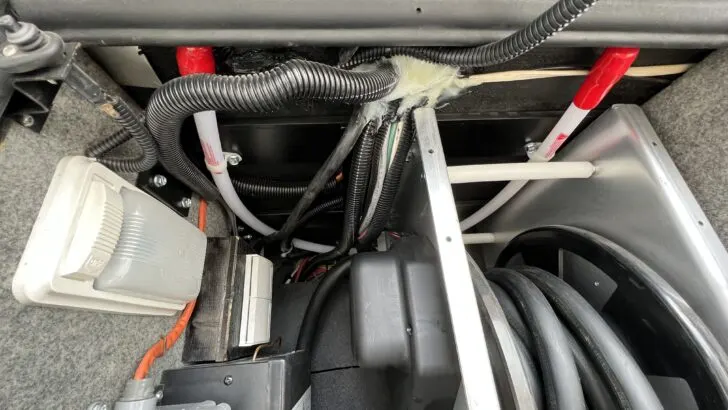
The white flexible tube with bright red end caps shown here is a Proteng RV fire suppression tube. This one is installed in our electrical bay. That’s our 50-amp RV power cord on the right, and the top of our transfer switch is visible in the lower part of the photo at the left/center. This entire area is now protected should a fire start here.
Proteng is an automatic fire suppression system that detects and extinguishes fire at its earliest stage — before it gets out of control. Appropriately sized flexible Proteng tubes are installed in high fire-risk areas.
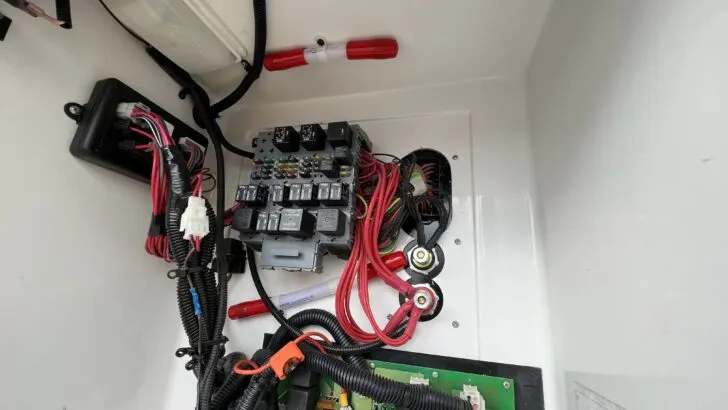
Can you spot the two small Proteng tubes installed above and between our fuse blocks? These small and unobtrusive fire suppression tubes protect this entire electrical area should a fire start here.
Proteng is a static system. It uses heat-sensitive/heat-activated tubes that are filled with a non-toxic and non-corrosive fire suppression agent (FM-200®) that leaves no residue behind, unlike traditional fire extinguishers.
Proteng offers three types and lengths of THIA tubes, which are chosen based on the area needing protection. (THIA by Proteng is an acronym meaning Tube + Heat = Instant Action.)
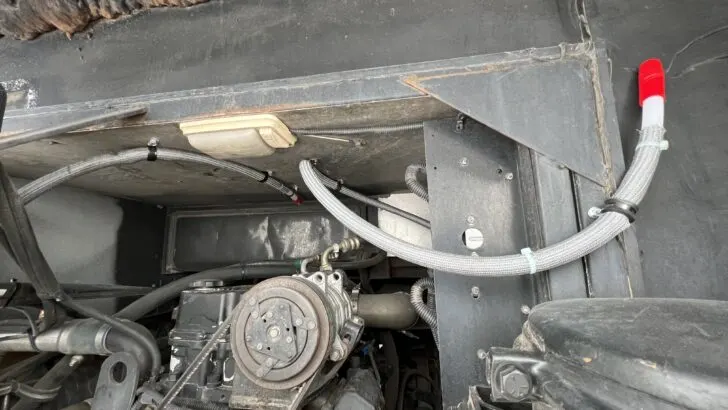
Note the longer tube installed in our engine bay. Tube lengths are determined by the area they’re protecting. This one is very long, enabling it to be looped around the engine and transmission, then back up to the top of the engine bay (visible on the left side). It’s also covered with a special sleeve to ensure that it isn’t triggered by a hot engine.
The system is able to detect and suppress fires in enclosed areas. We’ve always had some concern about that since RV fires often start in electrical, engine, or generator compartments.
Our favorite feature of Proteng’s RV fire suppression system is that it requires no action from us to operate. It is literally fully automatic. It doesn’t even require us to be on board the RV to do its job.
Now, we don’t travel with pets, but we have many friends who do. A fully automated fire suppression system that works even when a pet owner is off on a hike, having dinner in a restaurant, or simply running errands, offers the gift of peace of mind that no portable fire extinguisher can offer.
Our RV is our full-time home, so a fire suppression system is something we really should have installed a long time ago.
There are other “automatic extinguisher” systems on the market, but many of them have electronics and/or moving parts and require regular maintenance to remain effective. Proteng has no moving parts and nothing to maintain. It’s a dead simple way not to end up dead.
Below are several more photos of Proteng fire suppression system tubes installed in vulnerable areas of our RV:
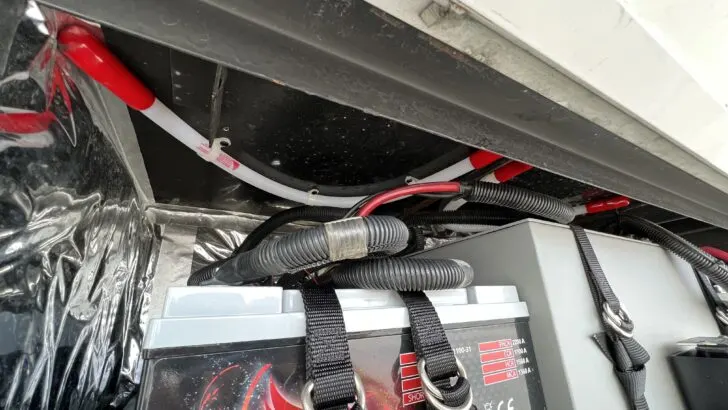
Proteng tubes installed directly above our AGM chassis batteries (left) and lithium house battery (right).
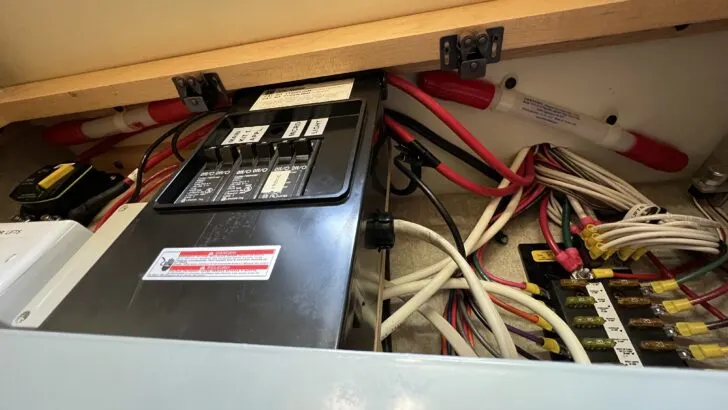
Can you spot the two small Proteng fire suppression tubes installed above our circuit breakers and fuse panel in our bathroom cabinet? If a fire started here, Proteng would detect it and automatically activate to extinguish the fire before it spread, even while we’re sleeping or away from the RV.
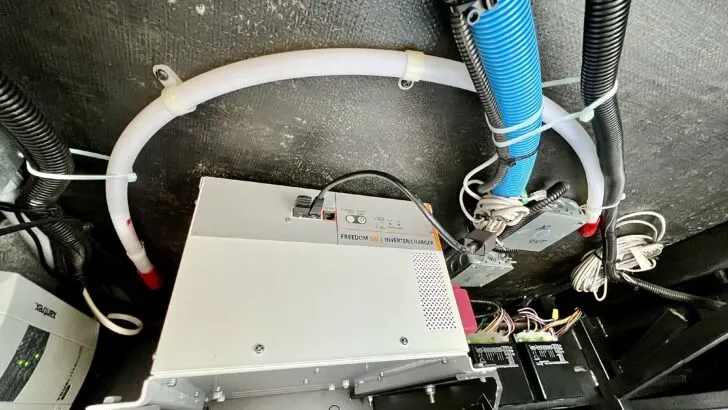
The Proteng fire suppression system will automatically protect us in the event an electrical fire should start at our RV’s inverter charger. We’ve now protected all major electrical areas from fire.
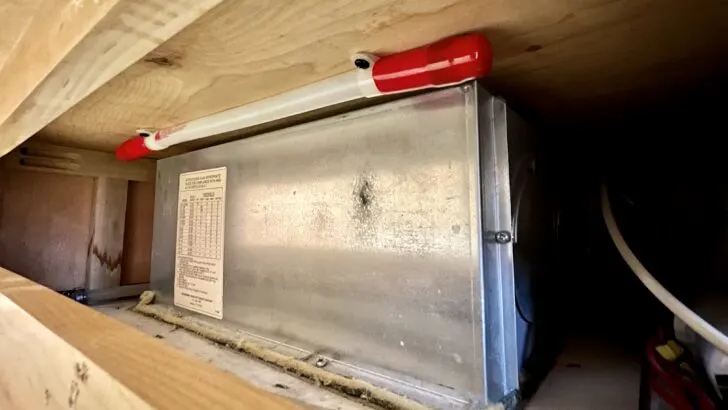
NIRVC also installed a Proteng tube above our propane furnace for obvious reasons. There’s also one above our water heater and another inside our generator housing. We’re protected from fire in all the most likely places. The one spot we didn’t need one (that many RVers do) is our fridge. That’s because we switched to a residential unit years ago, and they’re not fire hazards the way bi-fuel (propane/electric) RV fridges can be.
Why Proteng Over Other Fire Suppression Systems?
In addition to the reasons we’ve noted above, many other RV fire suppression systems offer a single area of detection where they’d release the fire suppression agent.
The Proteng system is a series of tubes that detect fire and release a suppression agent anywhere they’re installed. And since the areas of highest fire risk are the exact places NIRVC puts them, the danger of an RV fire is dramatically reduced.
Essentially, the area of a tube detecting the greatest amount of heat is where the Proteng system releases the FM-200® gas to extinguish the fire.
There are other automatic fire suppression systems on the market that might work well for others. But for us, the Proteng system checks all the boxes and covers the scenarios that concerned us, specifically the small enclosed spaces and high fire-danger areas for which the system is designed.
While no fire safety plan is guaranteed to be 100% effective against all RV fires, we added Proteng because it’s automatic peace of mind, plain and simple.
What’s Your Fire Safety Plan?
Drop us a comment below if you’d like to share your RV fire safety plan with others.
We’d also like to hear from you if you’ve experienced a fire on your RV or if you’ve installed a fire suppression system on your own rig. What did you choose, and (gulp) did it ever go off?!
Free RVing Tips, Tricks, Reviews, Giveaways & More
Subscribe to our daily newsletter! We’ve been full-time RVers for 20 years (!) and share everything we’ve learned about RVing in our daily blog posts. Join our online community to receive a wealth of great RVing knowledge delivered right to your inbox.
Whether this is your first time on the road or you’re a seasoned full-timer, you’ll love the wide range of RVing topics we cover. Don’t miss a single article or any of our famous RV gear Giveaways — Subscribe today!








Art
Friday 23rd of February 2024
What’s the cost of a fire suppression system!
TheRVgeeks
Friday 23rd of February 2024
Hi Art! The costs per tube vary a LOT based on their size and use. Most of the smaller ones retail for between $199 and $399. The only one that's REALLY expensive is the gigantic tube that protects the engine, transmission, and other components in the engine compartment of a big diesel pusher, which can run around $1,399. While it can certainly add up, the nice part about the system that we really liked is the modular aspect. You can pick and choose the things you're most concerned about and focus on them. For example, if we had an RV fridge, we would DEFINITELY protect that area, since they're a known fire hazard. Other areas that are less prone to fire risk, such as circuit breaker panels for example, we'd consider them less important, and the first to be left off the list when budget concerns come into play. The larger an RV, the more equipment it has, and an owner's level of risk tolerance are all factors.
Troy
Friday 23rd of February 2024
All good info to know. Another method of fire suppression we'd suggest would be a fire blanket. You can buy 2 packs of them on Amazon for around $15 and we keep one at home in the kitchen and another in our RV, easily accessible under the sink. Should a fire start and get out of control, say a grease fire in a pan or a candle on a table reach some paper, the blanket is a quick grab and can extinguish the fire faster than going through the motions with a spray type fire extinguisher and it'll do it without all the mess. Just our two cents. Thanks for the article!
TheRVgeeks
Friday 23rd of February 2024
Good point, Troy. Fire blankets are a great option to have on hand to extinguish a fire. The advantage of the "suppression" systems like ProTeng is that it can suppress/extinguish a fire that you didn't realize had even started. With a handheld extinguisher or blanket, human awareness and intervention are required. ProTeng works if you're onboard the RV or not!
Kevin
Tuesday 21st of March 2023
There was a Class A on fire in the RV Park yesterday. I found a lot of similar items on Amazon. Although one of the places I want to protect are more open than the say are right for these tube suppressors.
John Lee
Friday 24th of February 2023
Thanks for the article. What did the system cost for your RV?
John Lee
Saturday 25th of February 2023
@TheRVgeeks, Thank you, my Country Coach is a 45' like yours so probably a good ball park estimate for me. I was taken back by their comment that the system was not a primary protection system, but instead supplementary to somethings else. They say: PROTENG IS AN AUXILIARY AUTOMATIC FIRE SUPPRESSION AND DETECTION DEVICE TO SUPPLEMENT BUT NOT REPLACE ANY FIRE EXTINGUISHING SYSTEMS OR PRODUCTS. THIS PRODUCT IS NOT A FIRE EXTINGUISHING DEVICE AND CUSTOMER SHOULD NOT USE PRODUCT TO REPLACE ITS FIRE EXTINGUISHING SYSTEMS OR TO OTHERWISE MEET FIRE EXTINGUISHING REQUIREMENTS OF LAW.
All caps is their emphasis not mine. How does this affect how you use the product? What is your main protection?
Thanks John
TheRVgeeks
Saturday 25th of February 2023
Hi John! Keeping in mind that the system is HIGHLY customizable and different on every RV, we pulled out ALL the stops to have every single location throughout our rig protected, which was about $4,500 worth of work. But that's almost certainly the most expensive we'd think you could go, since we did it all. It's completely up to each RV owner exactly which areas they're most interested in protecting, and of course smaller or less heavily equipped rigs would surely come in less expensive.
Victor
Friday 24th of February 2023
There are also early notification mechanisms; i.e. bluetooth smoke detectors in key chassis or bay positions. We recently bought our Tiffin 33AA all electric which minimizes some likely sources but short of the Proteng expense we are considering early notification and extinguishers as a first step.